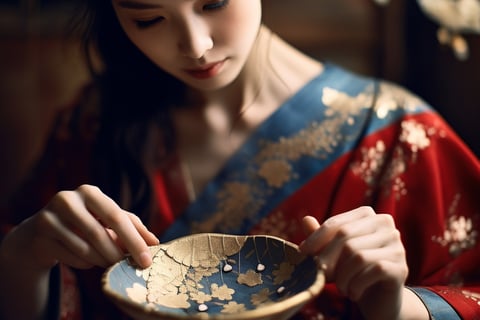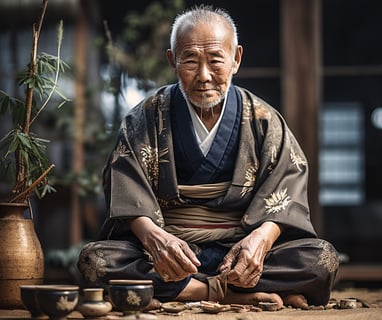The Birth of Kintsugi
The technique is believed to have originated in the 15th century, during the Muromachi period in Japan. However, it found its limelight in the 16th century, amidst the delicate Japanese tea ceremonies. The repaired cracks, glowing with golden sheen, were seen as reflections of the Japanese aesthetic principles of wabi-sabi, the beauty of imperfection.


The Kintsugi Process: A Masterpiece in the Making
So, how does a broken piece of pottery go from being a disaster to a masterpiece? The journey is fascinating:
1. Collecting the broken pieces: Every piece, however tiny, is precious and saved. After all, each fragment carries a part of the object's history.
2. Cleaning and preparing: The pieces are cleaned and prepped for the repair process. It's like a spa day for the broken pottery!
3. Applying the lacquer: Meet "urushi," the superstar lacquer responsible for holding everything together. It's applied along the edges of the broken parts and used to join them back together.
4. Dusting with powdered precious metals: Once the lacquer is applied, a generous sprinkle of powdered gold, silver, or platinum is added. The result? Beautiful lines that highlight the cracks, celebrating their existence rather than hiding them.
5. Polishing: Like a finishing touch, the surface is polished to ensure a smooth and even finish. The result is a piece of pottery that tells a story of resilience and transformation.


Applying Kintsugi to Your Life
What makes Kintsugi truly special is its philosophical underpinnings. It's about embracing imperfection and finding beauty in the broken or flawed. Instead of hiding the cracks and damages, Kintsugi celebrates them by turning them into a part of the object's history.
This approach also carries a metaphorical meaning, representing the idea that breakage and repair are an essential part of an object's existence, just as life's struggles and challenges shape our own stories.Imagine if you applied the principles of Kintsugi to your own life? Embracing your imperfections, learning from your experiences, finding strength in adversity, and cultivating resilience. Like the lacquer that holds the broken pieces together, build resilience to face life's difficulties and setbacks.
Just as Kintsugi celebrates the history and story of the object through its repaired cracks, celebrate your journey, both the successes and the struggles. Treat yourself with kindness and compassion, just as you would with a valuable piece of art. Focus on personal growth and continuous self-improvement.
Remember, like in Kintsugi, there's beauty in imperfection, strength in overcoming challenges, and the potential to create something even more beautiful and meaningful. By applying these principles in your life, you can navigate the ups and downs of life's journey with resilience and grace.
So the next time you break something, don't despair. Embrace the philosophy of Kintsugi, and remember, life is not about avoiding the breaks, but about how you put the pieces back together.
Imagine if you applied the principles of Kintsugi to your own life? Embracing your imperfections, learning from your experiences, finding strength in adversity, and cultivating resilience. Like the lacquer that holds the broken pieces together, build resilience to face life's difficulties and setbacks.
Just as Kintsugi celebrates the history and story of the object through its repaired cracks, celebrate your journey, both the successes and the struggles. Treat yourself with kindness and compassion, just as you would with a valuable piece of art. Focus on personal growth and continuous self-improvement.
Remember, like in Kintsugi, there's beauty in imperfection, strength in overcoming challenges, and the potential to create something even more beautiful and meaningful. By applying these principles in your life, you can navigate the ups and downs of life's journey with resilience and grace.
So the next time you break something, don't despair. Embrace the philosophy of Kintsugi, and remember, life is not about avoiding the breaks, but about how you put the pieces back together.




